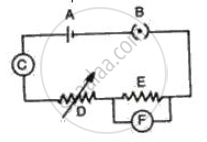Advertisements
Advertisements
प्रश्न
How is electric current related to the potential difference across the terminals of a conductor?
Draw a labelled circuit diagram to verify this relationship.
उत्तर
V = IR, where V is potential difference, I is current and R is constant for a given resistor as its resistance. Hence, current I is directly proportional to V.

APPEARS IN
संबंधित प्रश्न
Is Ohm’s law universally applicable for all conducting elements? If not, give examples of elements which do not obey Ohm’s law.
What is an Ohmic resistor?
What is the necessary condition for a conductor to obey Ohm’s law?
What length of copper wire of resistivity 1.7 × 10-8 Ω m and radius 1 mm is required so that its resistance is 2Ω?
In the circuit shown below in Fig, calculate the value of x if the equivalent resistance between A and B is 4 Ω.

Fig. represents the circuit used for the verification of ohm's law. Label the different parts from A and F. State the function of each.

Define ampere and volt with respect to Ohm’s law.
State macroscopic form of Ohm’s law.
Ohm's law deals with the relationship between ______
State Ohm's Law. Represent it mathematically.
